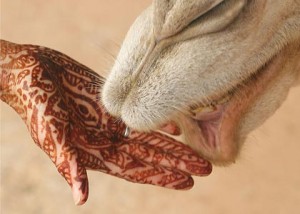Cleopatra Selene, was the Queen of Mauretania and she ruled over the ancient Berbers, the descendants of whom still live in North Africa. For my first novel, Lily of the Nile, I researched the magic of ancient Egypt because I wanted to know the spiritual traditions with which Selene would have been familiar. But for Song of the Nile, I wanted to learn all I could about the life of the people who called Selene their queen.
What I learned is that ancient Mauretania was every bit as exotic and sensual as Egypt, and that the women who lived there had a rich and colorful spirituality that expressed itself in their arts. We’ve all heard of Berber carpets. Perhaps we even own a piece of Berber jewelry. But the art of henna is largely associated with Indian culture now, even though it’s believed to have been of Berber origin.
Henna is a plant that, when dried, crushed to a powder, and mixed with oil to form a paste, can safely dye the skin–and the color will remain for weeks. Because of this and other medicinal properties, henna became an important part of Berber culture. Like the Egyptians, the Berbers believed in a kind of sympathetic magic, whereby symbols could take the place and power of actual things. For example, whereas the Egyptians might carve a cobra or a jackal-headed god at the entrance of a tomb to guard it, the Berbers might paint a sharp object on a pregnant woman’s belly as if to pierce the evil eye.
Whereas the Egyptians spent a great deal of time ornamenting tombs and creating magical amulets to be worn, the Berbers retreated to a more personal, more sensual connection to the supernatural world. By painting protective symbols on the body, the skin becomes its own talisman and magical protection. A manifestation of spirituality that is visible to anyone who might look upon the tattoos.
It’s interesting to me that while I used bloody hieroglyphs on my heroine’s arms and hands as a way of the divine world speaking through her, I hadn’t considered the use of symbols on her arms and hands as a way for her to speak back. At least, not until I learned more about the Berbers among whom Selene built a new life for herself.
While not exclusively reserved for women, Berber henna tattoos are inextricably entwined with women’s rituals. Henna tattoos are most often applied before a wedding, before and after birth, and before death. At all life’s thresholds, and, incidentally, all the times that a woman might need the comfort of others near her, rubbing her, pampering her, and seeing to it that she has adequate rest.
The henna paste can be made with oils–sandalwood is a popular one–so that the long process of painting intricate designs on the skin can give aromatic pleasure to all those involved. Berber women couldn’t easily tattoo themselves, so it become a bonding experience, and one of giving over the body to others in trust. And if that’s not magic, what is?



I recently discovered henna, but for hair dye. It is a long, but lovely process, even for hair. And its not something that you can do by yourself, so why not indulge in some pampering!!
I think I experimented with it once, though the set time was too long for me to wait so I got a faint color. I’d love to do it again 😉
While I was living abroad, there were many options for henna but you had to know what you were getting. Some of the artists used dye that was mostly hair dye and could cause some nasty allergic reactions!
Also interesting was that some of the more traditional Gulf Arab women didn’t bother with designs at all – they would just dip the sole of their foot in the red dye and also finger tips.
Yes, I’ve been warned away from so-called “black henna.”
I am half Berber and I have been to a few parties where henna was done. I have had the intricate henna, but mostly, I have had a circle in the middle of my palm, which is the most common. It is a very long process, but the herbs smell great! 🙂
Oh, thanks for stopping by! I’d love to attend a Berber henna party…